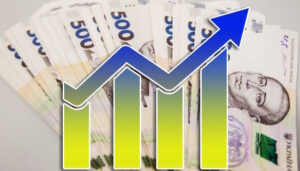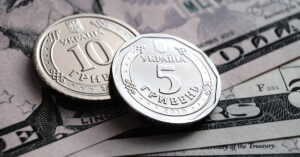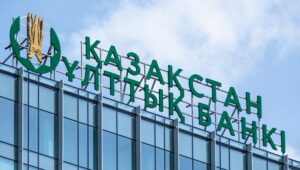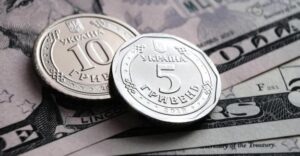
The gross domestic product (GDP) of Ukraine after a decrease in the first quarter of 2023 by 10.5% against the first quarter of 2022 in the second and third quarters switched to growth, is indicated in the explanatory note to the government’s draft state budget for 2024.
“According to estimates of the Ministry of Economy, at the end of eight months, growth is 3%,” the document says.
According to it, “certain types of economic activities” managed to quickly adapt to the consequences of the destruction of the dam of the Kakhovskaya HPP.
“Better than expected results of economic activity are due to the rapid adaptation of enterprises to the new conditions of activity together with the recovery of domestic demand, which was the traditional driver of growth of the Ukrainian economy in previous years,” – noted in the explanatory note.
First Deputy Prime Minister and Minister of Economy Yulia Sviridenko announced last week that the forecast for GDP growth in 2023 had been raised to 4%, but the explanatory note still says that the economy will grow by 2.8% this year with inflation at 14.7%, although it fell to 8.6% in August.
According to the explanatory note, the Ministry of Economy as of mid-June this year predicted GDP growth next year by 5% with inflation falling to 10.8% at the end of the year.
The National Bank of Ukraine in late July raised its forecast for Ukraine’s GDP growth in 2023 from 2% to 2.9%, but lowered it for 2024 from 4.3% to 3.5%. In addition, the NBU improved its inflation estimate this year from 14.8% to 10.6%, and next year – to 8.5%.
Experts Club Research Project and Maxim Urakin recently released an analytical video about the economy of Ukraine and the world.
You can subscribe to the Experts Club YouTube channel by following the link – https://www.youtube.com/@ExpertsClub

The European Commission (EC) has downgraded its forecast for eurozone economic growth in 2023 to 0.8% from the previously expected 1.1%.
In 2024, eurozone GDP is expected to grow by 1.3% rather than 1.6%, the EC said in a review.
The forecast for EU economic growth for this year has been worsened to 0.8% from 1% and for next year to 1.4% from 1.7%.
“The latest statistical data confirm that economic activity in the EU has been subdued in the first half of 2023 due to the severe shocks facing countries in the region. Weakness in domestic demand, especially consumer spending, shows that high prices for most goods and services are putting more pressure on the economy than we believed in our previous forecast,” the survey said.
“The sharp contraction in bank lending suggests that monetary tightening in the euro area is having an impact on the economy,” the EC said. – Various surveys point to a slowdown in economic activity over the summer and the following months. Weakness in the industrial sector persists, and the impetus for growth in the services sector is weakening”.
EC experts emphasize that the situation in the world economy in the first half of the year was slightly better than expected, despite the weak dynamics in China. Nevertheless, the EC forecasts for the world economy and international trade volumes are practically unchanged, which means that European countries cannot count on support from external demand.
The EC expects global GDP to expand by 3.2% both this year and next year.
“The momentum towards slower growth in the EU is likely to continue into 2024, as tight monetary policy will continue to constrain economic activity. At the same time, we expect GDP growth to pick up slightly next year as inflation slows, the European labor market remains strong and household incomes gradually recover,” the EC review said.
The eurozone inflation forecast (HICP index) for this year has been lowered to 5.6% from 5.8%, for next year – raised to 2.9% from 2.8%. In the EU, according to the EC’s updated forecast, inflation will be 6.5% this year (previously 6.7%) and 3.2% next year (previously 3.1%).
The EC expects that energy prices in Europe will continue to decline until the end of 2023, but more slowly than before. At the same time in 2024 they may again slightly increase due to the expected rise in oil prices.
The EC review notes that the war in Ukraine and other geopolitical factors still carry risks for Europe.
In addition, experts warn that the tightening of monetary policy may put more pressure on the economy than expected at the moment. On the other hand, it may lead to a faster easing of inflation and, accordingly, accelerate the recovery of real incomes, the review notes.
According to the EC’s forecast, Germany’s GDP will contract by 0.4% in 2023 and grow by 1.1% next year. Previously expected to increase the first indicator by 0.2%, the second – by 1.4%.
France’s economic growth forecast for 2023 has been raised to 1% from 0.7%, for the next year it has been lowered to 1.2% from 1.4%.
Italy’s economy is expected to grow by 0.9% and 0.8% in 2023 and 2024 respectively, while Spain’s is expected to grow by 2.2% and 1.9%.
Experts Club Research Project and Maxim Urakin recently released an analytical video about the economy of Ukraine and the world.
Subscribe to the Experts Club YouTube channel by clicking here – https://www.youtube.com/@ExpertsClub

The Ministry of Economy has raised its forecast for Ukraine’s gross domestic product (GDP) growth in 2023 to 4%, First Deputy Prime Minister and Minister of Economy Yulia Svyrydenko said in Kyiv on Saturday at the annual meeting of the Yalta European Strategy organized by the Victor Pinchuk Foundation.
“This year, we believe that GDP growth will be 4%, although pessimists believe that 3%… We have maintained macro stability, this is the basis for further recovery of Ukraine,” she said.
Svyrydenko clarified to Interfax-Ukraine that the government has not yet approved the forecast for 2024, while the National Bank of Ukraine expects GDP growth of 3.5%, and up to 6.8% in 2025.
“We are always more optimistic than the National Bank,” the First Deputy Prime Minister and Minister of Economy said.
She added that inflation, according to the NBU’s forecast, will slow to 10.6% this year, and core inflation to 9%.
In her speech, the First Vice Prime Minister also reminded that the NBU had recently cut the discount rate to 22% per annum.
“As a participant in this discussion, I will say that I was in favor of a bigger reduction. I think that our macroeconomic situation allows us to be more flexible, but, as always, realistic,” Svyrydenko said.
According to her, the Ministry of Economy sees improvements in the agricultural sector and expects that in November a working instrument for military insurance will be created through the efforts of both the Ukrainian government and the European Bank for Reconstruction and Development (EBRD).
The First Deputy Prime Minister emphasized that the government is also actively working on a four-year development plan under the Ukraine Facility program announced by the EU, which will start operating in early 2024 and will become the basis for further growth of its economy.
As reported, in June, the Ministry of Economy slightly downgraded its GDP forecast for this year from 3.2% to 2.8% due to the destruction of the Kakhovka hydroelectric power plant and pessimistic expectations for the upcoming harvest. According to Natalia Gorshkova, Director of the Strategic Planning and Macroeconomic Forecasting Department of the Ministry of Economy, in early August, the Ministry had already assumed economic growth of 5% in 2023, but so far it has conservatively maintained the 2.8% estimate, taking into account the existing risks. At that time, the Ministry of Economy predicted that GDP growth would accelerate to 5% next year, with inflation slowing to 10.8%.
At the end of July, the National Bank of Ukraine raised its forecast for Ukraine’s GDP growth in 2023 from 2% to 2.9%, but lowered it for 2024 from 4.3% to 3.5%. In addition, the NBU improved its inflation estimate this year from 14.8% to 10.6%, and next year to 8.5%.
In August, inflation in Ukraine fell to 8.6% in annual terms.
The Experts Club research project and Maksym Urakin recently released an analytical video about the economies of Ukraine and the world – https://youtu.be/zCJ1cU3n0sY?si=LFj-pDmojahwtHkA
You can subscribe to the Experts Club YouTube channel at https://www.youtube.com/@ExpertsClub

Stably high interest rates in the world’s largest economies mean that global economic growth is likely to slow in 2024 after this year’s rate of recovery exceeded expectations, the Financial Times writes, citing the opinion of economists.
Thus, according to the forecast of the consulting company Consensus Economics, in 2024 GDP will grow by 2.1% compared to 2.4% expected in the economy this year. Meanwhile, the estimate for 2023 was raised from the 1.4% assumed at the beginning of the year due to unexpectedly strong consumer demand and labor market.
Capital Economics senior global economist Simon Macadam also believes that the expected slowdown in economic growth next year will be partly due to a more substantial rebound in 2023. However, he added that economists “have actually become more pessimistic about the outlook for 2024”.
This is due to beliefs that persistently strong demand will keep inflation higher for longer, pushing advanced economy Central Banks to keep rates high throughout the year.
“Demand is barely weakening, the labor market remains strong, and wages continue to rise,” notes Citi Chief Economist Nathan Sheets. – Some of the weakening in the economy (which was expected this year – IF-U) is being carried over to 2024.” In many countries, including the U.S., “there will be a recession, it will just come later,” he predicts.
Until a few months ago, the Federal Reserve was expected to start cutting rates this year. But the resilience of the U.S. economy indicates there is a small possibility that the Fed could raise borrowing costs by another quarter-point in September, to 5.5-5.75% per annum. And economists now expect the first rate cut to occur next spring.
The high probability that the U.S. economy will avoid recession this year “means the Fed will hold rates higher longer to fully suppress inflation, leading to slower growth in 2024,” according to Mark Zandi, chief economist at Moody’s Analytics.
On average, economists forecast the U.S. economy to rebound 0.6% in 2024 after expanding 1.9% at the end of this year.
Europe’s economies have also performed “somewhat better than expected” this year, with the exception of Germany, meaning the European Central Bank and the Bank of England are also likely to keep rates on hold for longer, Zandi said.
The ECB raised its deposit rate from minus 0.5% per annum in June 2022 to the current 3.75% and is not expected to cut it for most of next year. The Bank of England is forecast to increase its cost of borrowing by a further half a percent to 5.75% by the end of this year and is unlikely to start cutting it until the second half of 2024.
Christian Keller, head of economic research at Barclays, notes that the negative investor sentiment towards 2024 is also due to a slowdown in China’s GDP growth after a significant acceleration following the removal of anti-Kowitz restrictions.
Experts Club Research Project and Maxim Urakin recently released an analytical video on the Ukrainian and global economies
You can subscribe to the Experts Club YouTube channel at https://www.youtube.com/@ExpertsClub

The National Bank of Kazakhstan has raised its economic growth forecast for 2024-2025 to 4-5% per year from the previously expected 3.5-4.5%, the regulator said in a statement citing its updated macroeconomic forecasts.
This year, GDP growth is still expected to reach 4.2-5.2%.
“Forecasts for the growth of Kazakhstan’s economy in the medium term have been improved. The expansion of business activity will be driven by sustained domestic demand, increased budget expenditures and the recovery of the oil sector. (…) The risks to the GDP forecast are associated with possible problems of access to international markets for Kazakh exports, as well as the likelihood of not achieving the planned oil production,” the statement said.
In addition, the inflation forecast has been adjusted. In the short term, uncertainty about price growth has decreased. In the baseline scenario, inflation is projected to be in the range of 10-12% this year (previous forecast – 11-14%), 7.5-9.5% in 2024 (9-11%), and 5.5-7.5% in 2025 (corresponding to the previous forecast).
“At the same time, without taking into account the direct effect of the increase in utility tariffs, to which the NBU does not respond by changing the key policy rate, the medium-term inflation target of 5% is expected to be reached by the end of 2025. This will be facilitated by the further easing of pressure from the external environment and monetary conditions that are in the restraining zone,” the statement said.
The main risks to the inflation forecast, according to the National Bank, include increased fiscal stimulus, “unanchored inflation expectations,” accelerating inflation in Russia and a possible rise in world food prices due to the failure to renew the grain initiative. Another risk in the forecast is the continuation of pricing reforms in the Kazakh fuel and lubricants market.
Kazakhstan’s economy grew by 3.1% in 2022, with inflation at 20.3%.
For more information on macroeconomics, please see the analytical programs of the Expert Club at https://youtu.be/zCJ1cU3n0sY?si=zfnGIkt5zdhX_j3x

Ukraine’s real gross domestic product (GDP) growth by the same period last year slowed to 8% in July from 15% in June, primarily due to a high statistical base as the rate of GDP decline slowed significantly in the third quarter of last year, according to the Institute for Economic Research and Policy Consulting (IER).
“Economic activity is not yet close to pre-war levels: we estimate that GDP has fallen by 25% compared to July 2021,” the IEI said in its monthly economic monitor.
The institute estimated the increase in real gross value added (GVA) in July in the processing industry at more than 20% due to the recovery of all industries from a low base, while the extractive industry saw a small increase.
According to the IEI experts, agriculture grew by almost 5% in July, primarily due to the lower statistical base of July 2022. The grain harvest was close to last year’s due to higher yields.
“The growth rate of real GVA in transportation slowed to 9% y/y, while GVA in trade continued to grow rapidly, by about 27% y/y,” the report said.
As reported, the State Statistics Committee has not yet published its assessment of the dynamics of GDP of Ukraine in the second quarter, while at the end of the first quarter it reported a 10.5% decline in the economy.
Earlier, the IEI estimated Ukraine’s GDP growth in the second quarter of this year at about 20-21%: almost 22% in April, 20.9% in May and 15.3% in June.
According to the National Bank, Ukraine’s GDP grew by 18.3% in the second quarter. The NBU forecasts that the economic recovery will slow to 4.6% in the third quarter of 2023 and 1.8% in the fourth quarter, which would translate into year-on-year growth of 2.9%.